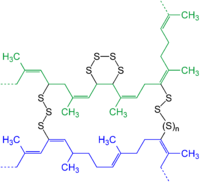
Photo from wikipedia
Abstract Post-crosslinking strategy has proven highly versatile for the facile and efficient fabrication of photomobile azobenzene (azo) polymer actuators because of the easy processing of uncrosslinked azo polymers into any… Click to show full abstract
Abstract Post-crosslinking strategy has proven highly versatile for the facile and efficient fabrication of photomobile azobenzene (azo) polymer actuators because of the easy processing of uncrosslinked azo polymers into any desired physical formats and the mild crosslinking conditions, but the general knowledge on the detailed structure-property relationship of the as-prepared photomobile polymers still remains elusive up to now. Herein, we demonstrate for the first time the important structure-property relationship of the post-crosslinked azo polymer fibers by systematically studying the effects of the post-crosslinking conditions and chemical structures of the azo polymers on their photomobile behaviors. A series of easily crosslinkable side-chain azo polymers with different length of flexible spacers and varying contents of N-hydroxysuccinimide carboxylate-substituted azo mesogens were prepared via free radical polymerization for such a purpose. Their uniaxially oriented fibers were first fabricated by using the simple melt spinning method and then subsequently crosslinked with several primary diamines for different time to afford the post-crosslinked fibers. Significant influence of the post-crosslinking conditions and chemical structures of the azo polymers on the photomobile properties of the post-crosslinked fibers was observed. The construction of an appropriate crosslinked polymer network with moderate azo contents and structure flexibility proved to be of the utmost importance for achieving optimal photomobile polymer fibers, which is likely to be due to their generation of high enough photomechanical force upon photoirradiation and efficient transportation of such microscopic force across the entire network into macroscopic motion. The as-prepared post-crosslinked azo fibers could exhibit rapid, large, and reversible photoinduced bending and unbending at room temperature, and show excellent fatigue resistance and good mechanical properties. We believe the results presented here pave the way for rationally and efficiently developing various advanced photodriven actuators via this post-crosslinking strategy.
Journal Title: European Polymer Journal
Year Published: 2020
Link to full text (if available)
Share on Social Media: Sign Up to like & get
recommendations!